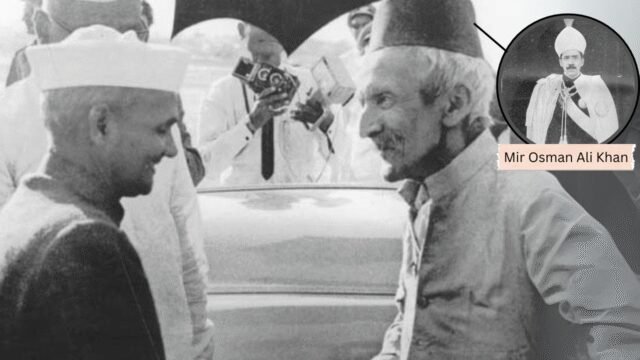
The Nizam with the then Prime Minister of India Lal Bahadur Shastri (Wikimedia Commons)
The story goes: Prime Minister Lal Bahadur Shastri visited Hyderabad to raise funds, and the Nizam—moved by patriotic fervour—donated the gold, requesting only that the boxes be returned.
This story has often been celebrated as a symbol of loyalty and generosity. However, new findings reveal that this popular tale may be more myth than fact.
Debunking Myths, One RTI A Time
This story has often been celebrated as a symbol of loyalty and generosity. However, new findings reveal that this popular tale may be more myth than fact.
Instead, official records show that the Nizam invested 4.25 lakh grams (425 kg) of gold—not 5,000 kg—in the National Defence Gold Scheme, launched in October 1965. This was not a donation but an investment, which also offered a lucrative 6.5% interest per annum.
As per The Hindu‘s archive dated December 11, 1965, Prime Minister Shastri publicly acknowledged the Nizam’s contribution at a public meeting in Hyderabad. The gold was deposited in the form of antique coins or mohurs, valued at around ₹50 lakh. Due to their antiquity, the government hoped to fetch even higher returns by selling them abroad.
The same report mentions other significant contributions: 1.25 lakh grams of gold from the Tirumala Tirupati Devasthanams (TTD) and ₹8 lakh in cash from Telugu film stars. These were actual donations, unlike the Nizam’s interest-earning deposit.
Not A Donation, But A Strategic Investment
This claim has driven many media outlets to find the truth on their own and in one such quest, the News18 also reported that the Nizam’s 425 kg contribution was not a donation but a strategic investment. This investment came after Shastri’s appeal during his fundraising visit to Hyderabad. It was part of a broader economic and patriotic push that encouraged citizens to contribute to national causes, such as the newly established National Defence Fund in 1962.
The Defence Gold Bond scheme served as a tax amnesty initiative, allowing people to invest undeclared gold without facing legal consequences under customs or income tax laws.
Interestingly, an RTI query to the Reserve Bank of India (RBI) about the final beneficiary of the Nizam’s investment was rejected under Section 8(1)(j) of the RTI Act, citing privacy. Najaf Ali Khan, one of the Nizam’s grandsons, told The Hindu he was unaware of who received the eventual payout, adding that although the Nizam had created 52 trusts, he did not know which one, if any, had benefited.








